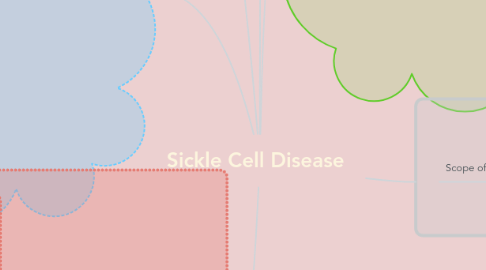
1. Sickle cell disease is an inherited blood disorder, specifically of the erythrocytes or of the hemoglobin molecules
1.1. In normal red blood cells, a circular structure allows for appropriate binding of hemoglobin, thus permitting sufficient oxygen transport to the body's tissues
1.2. In patients with sickle cell anemia (HbSS), the erythrocytes become sickle shaped, as well as sticky and rigid. This structural malformation creates a difficult environment for hemoglobin to bind.
1.3. In patients with HbSC, the hemoglobin molecule itself is abnormal, hindering proper delivery of oxygen to tissues
2. Impact of SCD on Patients and Their Families
2.1. An overwhelming symptom for patients and their families to deal with are pain crises. These are caused by damage to the blood vessels via the sickled cells, and preventing oxygen to vital tissues.
2.1.1. Not only is it difficult to go through painful episodes like this, but to watch a family member (especially your child) go through it can be horrific.
2.2. Dealing with the information that a patient is either a carrier or has SCD can be intense. Genetic counseling is often a component of patient care for those who seek to have offspring while having the condition themselves.
2.3. Chronic complications of the disease include anemic states, headaches, gallstones, jaundice, fatigue, leg sores, and organ failure
2.3.1. Not only do some of these symptoms lower the quality of life for a patient, but some are life-threatening as well.
3. Ethical & Legal Considerations
3.1. One ethical issue care providers face while treating their SCD patients is pain management. Especially during acute pain crises, patients often go under-prescribed. While it is important to only prescribe prescription strength pain medications, it is also unethical to keep a patient in that state of pain or discomfort.
3.2. Another issue is with prenatal testing procedures
3.2.1. Amniocentesis and Chorionic Villus Sampling, while relatively safe, can still pose a risk for miscarriage and should be noted.
3.2.2. Other ethical concerns surround the appropriateness of aborting a fetus found to have SCD.
3.2.2.1. Culture, religion, and psychosocial relations must be discussed surrounding this decision
3.2.2.2. It is also more common to find SCD in countries with unsafe or improper healthcare practices, making an abortion procedure dangerous for both the fetus and the mother.
4. Symptoms: Anemia, intermittent bouts of pain (pain crises), edema of distal extremities, frequent infections, delayed growth,
5. Genetic & Genomic Assessment Considerations of Sickle Cell Disease
5.1. Sickle cell is an autosomal recessive disorder. If both parents are carriers: 1/4 chance of not having the SCD or trait, 2/4 chance of being a carrier of the trait, 1/4 chance of having SCD.
5.2. A simple blood test is utilized to determine the presence of an abnormal S (sickle) gene or an abnormal C (hemoglobin) gene. Two S genes indicate sickle cell anemia, the presence of the abnormal C gene indicates HbSC.
6. Scope of Practice for SCD
6.1. As the nurse for a patient diagnosed with Sickle Cell Disease, it is important not to promise health improvement or results. SCD is a recurring, often chronic disease that will not go away (as there is currently no cure)
6.1.1. Offering support and resources for pain management, therapy, and simply providing a confidante to share concerns and fears with are all necessary components of the scope of practice for a nurse in this area of medicine.
